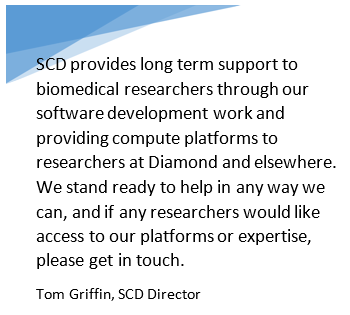Immediately following the release of the genetic sequence by the Chinese, the structural biology community swung into action to determine the three dimensional structures of the proteins produced by the virus. These will form the basis for efforts to find inhibitor drugs and vaccines.
drugs and vaccines.
SARS-CoV-2 holds its genetic material in a single strand of RNA which encodes for structural proteins and key enzymes used in its lifecycle. One of these proteins forms the spike visible on the outside of the virus, and which it uses to gain entry to human cells.
Electron cryo-microscopy has been used to determine the shape of this spike protein captured at three different stages, while macromolecular crystallography has determined more detailed structures of specific parts of this protein. As the external face of the virus, the spike protein is the principle target for vaccine development, and the first trials now taking place are based on synthetic versions.
Crystallography has also revealed details of some of the other proteins, in particular the two proteases which are important drug targets. Efforts are already underway to screen potential drugs against these viral enzymes, including work done on the XChem beamline at the Diamond Light Source (Diamond).
Generation of this structural information relies on virologists having access to the latest tools, both in the laboratory and for subsequent computational analysis. The CCP4 and CCP-EM projects coordinated by STFC's Scientific Computing Department (SCD) develop software for determining protein structures by crystallography and electron microscopy respectively, and form part of the toolkit being used against Covid-19.
Martyn Winn, head of SCD's Computational Biology group, said “Many years of work by ourselves and our collaborators have gone into producing and distributing the best software. We are proud that our software can help in the fight against this disease. We are continuing to look for ways to contribute to the international effort."
SCD's Computational Biology Group is mainly based in the Research Complex at Harwell and works alongside colleagues from the Medical Research Council (MRC), which funds CCP-EM and co-funds CCP4 alongside the Biotechnology and Biological Sciences Research Council (BBSRC). All of these partners are working tirelessly to support the research effort for Covid-19.
Other Collaborative Computational Projects (CCP) research communities are also coordinating their efforts - more news here.
Diamond's work on a very large screening experiment (see 'Taking fragments to impact') and the crystallography work on the XChem beamline requires substantial computing capability and software, some of which is being provided by the e-infrastructure resources from IRIS, which form part of the STFC Cloud.
STFC Cloud and Tier-1
STFC has a dedicated cloud infrastructure which provides compute resources across all STFC facilities. Run by SCD, it is designed to be very flexible and allow users to perform complex data analyses without the challenges of running their own infrastructure.
The STFC Cloud currently has some spare Graphics Processing Unit (GPU) capacity and is donating ~P100 GPU cards and 2,000 Central Processing Unit (CPU) cores to the Folding@home project for their efforts in analysing and understanding Coronavirus. A further 13,000 new CPUs have now been installed within SCD at STFC's Rutherford Appleton Laboratory (RAL) and these are also being used in support of this effort.
In addition, the UK Tier-1 facility at RAL, which stores and processes vast amounts of data from the Large Hadron Collider, is donating around 30,000 CPU cores to Folding@home. The jobs being processed are linked to the work being carried out at Diamond.
Other SCD support
Juan Bicarregui who heads our Data Division is co-chairing the RDA Covid-19 fast-track working group
The SCARF platform is providing additional CPU resources to researchers at Oxford University who are working with Diamond.
Our Software Engineering Group is helping other facilities with software, and with open data, assigning Digital Object Identifiers and creating landing pages.
Notes:
The Diamond Light Source is funded by UK Research and Innovation (UKRI) and the Wellcome Trust. It is located alongside the Research Complex at Harwell (RCaH), and other UK National Facilities - which include STFC's, Central Laser Facility, ISIS Neutron and Muon Source, RAL Space, and many others - all based at the Rutherford Appleton Laboratory, part of the Harwell Campus in Oxfordshire.
All of these facilities, Research Councils and partner research organisations at Harwell and other sites around the UK, and in other countries across the globe are working together in this vital research effort.
